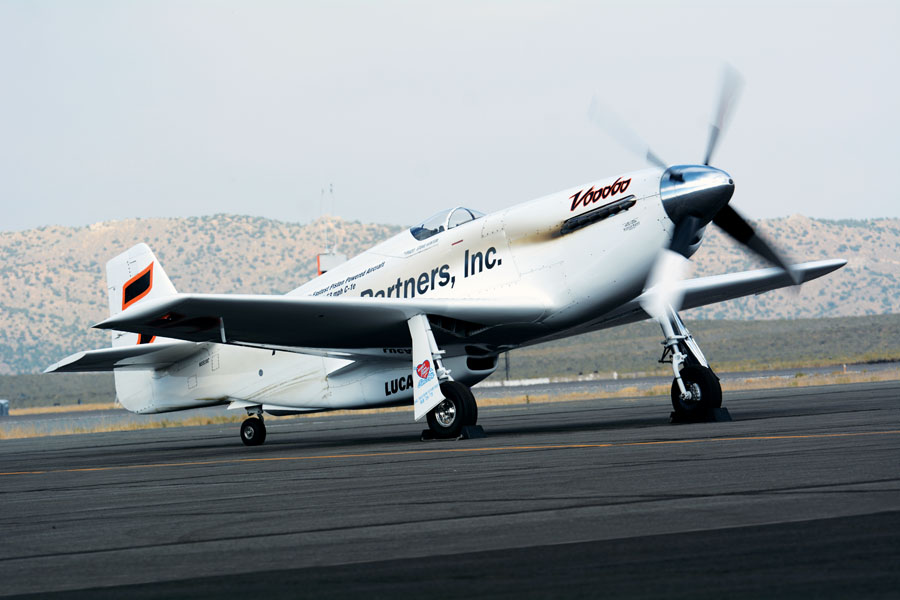
Fresh off the Reno racecourse, Voodoo shows telltale exhaust stains and oil streaks as Steveo runs up the Merlin prior to shut down. Just how many stock P-51 parts remain on Voodoo is a fair question, but there are likely more experimental, handmade parts.
What’s a nice P-51 like Voodoo doing in a magazine like this? Well, Voodoo is an experimental, is arguably mainly homebuilt, and to a small extent by names well known in the KITPLANES world. In short, hero class or not, this financial black hole that’s so specialized it’s good for nothing except going fast is one of us. A very, very fast one of us.

Second-generation racer Steve Hinton Jr.—Steveo in the pylon world—combines piloting and mechanical skills far advanced than his relative youthfulness would suggest. He says Voodoo’s handling is nearly unchanged with the new wing. There is a slightly larger pitch-down when the flaps are going from 10 to 30 degrees, and it takes a slightly steeper angle to make 140 mph on the landing approach, but otherwise it’s the same old hot, noisy ride it’s always been.
And it’s that speed that got us curious. Last August Steve Hinton Jr.—Steveo to his friends—piloted Voodoo to a C-1e class record of 531.53 mph. This may not be the ultimate propeller-driven speed, which still belongs to the Russian Tu-95 Bear bomber or its Tu-114 airliner variant using four 15,000-hp turboprops at 540 or 575 mph depending on where you read. It also turns out not to be the C-1 Unlimited piston engine speed record; that’s still held by Bob Shelton in the air racing F8F Bearcat, Rare Bear, at 528.33 mph because Voodoo barely didn’t surpass Rare Bear’s record by 1%, or 533.59 mph—an excruciatingly small 2.06 mph miss. But it’s still screaming fast, and as it turns out, not truly representative of what a fully healthy Voodoo can run, which is up to 550 mph.
Think about that for a second—550 mph. Most of us are impressed by a 250 mph Lancair, which isn’t half as quick. Even Jeff LaVelle’s very impressive and mega-powered Glasair III has averaged 410 mph around the Reno pylons and would likely bust 430 mph in an all-out, straight-line record run. That’s still 120 mph behind Voodoo, and every last one of those 120 mph are at the tough end of a scale where aerodynamic drag increases by the square of the speed, and propeller efficiency is fading like the dawn of the jet age. When you get down to it, even with seemingly unlimited money and cubic inches, how does Voodoo possibly go that fast?
Principles
Bob Button would certainly laugh about our “unlimited” money comment. As Voodoo’s owner, he knows just how limited the white racer’s budget really is. After all, Button runs a successful trucking firm and automotive dragsters on the side, so Voodoo flies courtesy of a sportsman’s wallet. But both the knowledge behind its modifications and many of those modifications are the result of cumulative effort, both from air racing in general and more specifically back to when Bill Speers birthed this air racer as Pegasus in 1988.
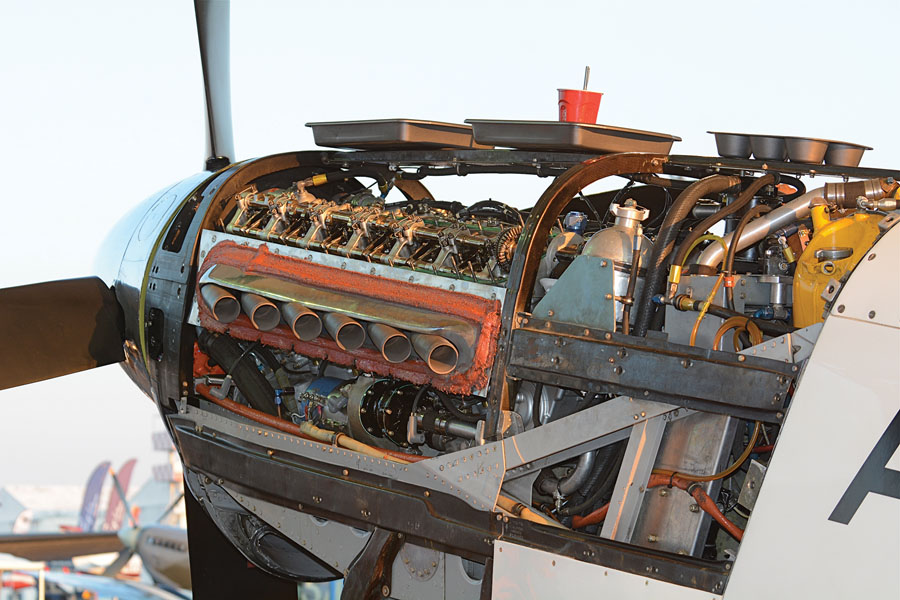
Ancient but highly developed, Voodoo’s Rolls-Royce V-12 is a powerful argument for water cooling and forced induction. Packing huge cubic inches in a bit more frontal area than a big air-cooled Lyc or Continental, it also offers the aerodynamic benefit of a well-packaged, pressure-recovering radiator. Not talked about much, very high octane gasoline—upwards of 160 octane—is key to these engines’ prodigious output.
Pivotal to the recent record run is Joe Clark, owner of Aviation Partners. As Button explained, “Joe has wanted to set the 3-kilometer record with the Mustang [for a long time]. He and Chuck Lyford were partners…and tore up downtown Seattle back in, must have been the 1960s.” Lyford was an early Reno P-51 racer, hence Clark’s allegiance in the long-standing inline vs. round motor rivalry among air racers.
Today Aviation Partners is noted as the place for winglets and other aerodynamic devices on large commercial aircraft, so Clark brought considerable resources, both financial and technological, to the record attempt. His participation began when Button approached Clark regarding the record run.
At the cost of slighting many other long-standing Voodoo team members, three names KITPLANES readers are familiar with have ties to Voodoo. Dr. Paulo Iscold, late of Brazil and now associated with Catto Propellers in California, consulted on aerodynamics and flight profile optimization, Craig Catto analyzed the propeller, while Andy Chiavetta of Aerochia has been working his magic on Voodoo in earnest since 2015.

All serious racing P-51s employ a stock propeller with the tips trimmed into a shorter, curving semi-scimitar to delay transonic issues. Voodoo’s stock prop was cut in 2015; Craig Catto analyzed it prior to the record attempt and said, “It would be really cool to build new blades. The [existing] blades aren’t anywhere near optimum, but we didn’t have any time to do anything.”
On the Wings of Giants
So, just what did the Voodoo team have to work with for the record attempt? Not to get too macro-historical about this, but in the summer of 2017 there were just two piston airplanes ready to race at this level, and they stand at the extremely sharp point of a very long and tapered spear, which has its base in 1933 when Rolls-Royce started work on the Merlin V-12. Those two airplanes were Strega and Voodoo, both highly modified P-51 Mustangs. The foundation of their performance began in earnest with the epic research in aerodynamics, piston engines, fuels, and propellers during WW-II, followed by seven decades of hard-won development by racers. In fact, as Chiavetta pointed out, Voodoo in record attempt form not only wore some new ideas, but for the first time incorporated in one airplane all of the good modifications previously spread across a series of Reno racers.
Thanks to this extended prologue, Bob Button and the many people he’s worked with in the 23 years he’s owned Voodoo were able to consider a run at the piston speed record using an airplane that was already immensely refined, as we’ll review shortly. The final steps to the record were aerodynamic, but as with all successful racing endeavors, it took everything to reset the C-1e record.
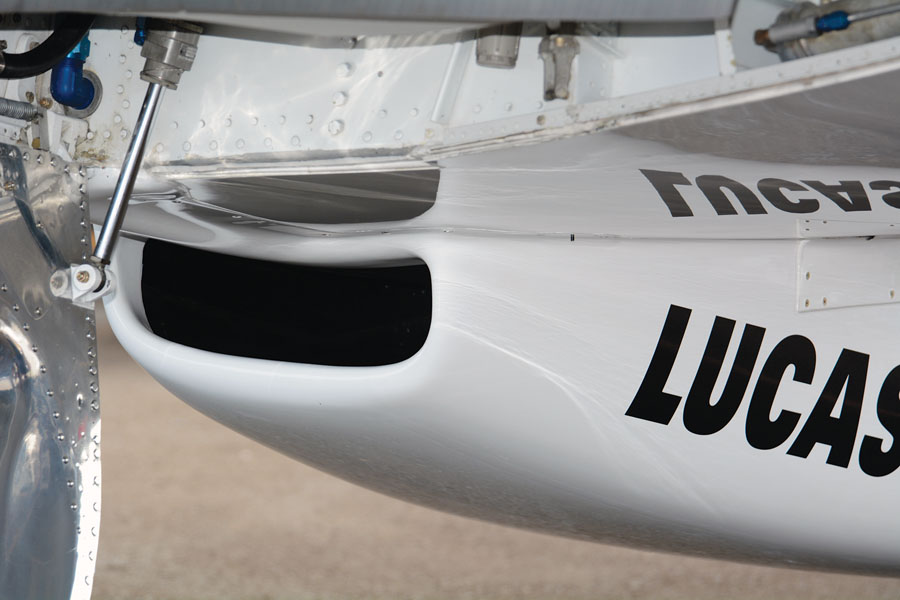
Stock P-51 belly scoops stand below the boundary layer for better scoop efficiency, but racers find tucking the scoop hard against the fuselage increases speed simply due to reduced frontal area. Also, race teams greatly increase cooling effectiveness via spray bar water, so scoop efficiency is subordinate to reducing drag.
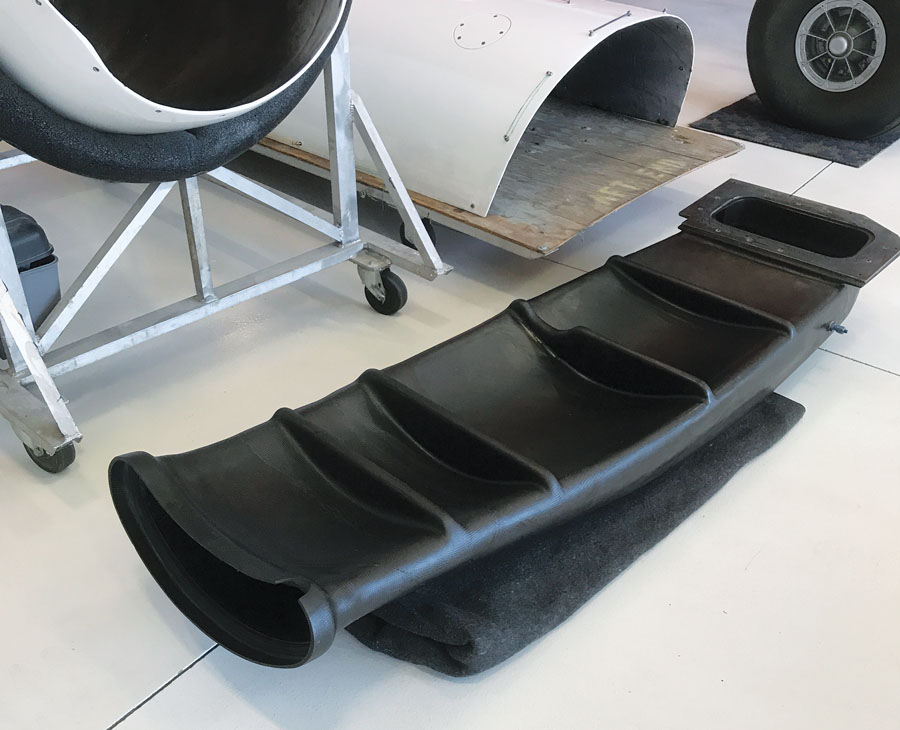
Running from under the spinner to the back of the engine, the stock aluminum air inlet trunk was replaced by this carbon fiber piece built by Andy Chiavetta. Frangible ribs accommodate the occasional backfire as proved during the record runs when the easy-opening duct minimized collateral damage and was repaired after a few hours of carbon layup work.
Glorious Noise
To start, it takes power to go fast. Unfortunately it’s well beyond this article to detail the development of the two Rolls-Royce Merlins the Voodoo team keeps handy, other than to note the team used to build their own engines, but since 2016 has given the job to Vintage V-12s in Tehachapi, California. For those not familiar, the Merlin displaces 1650 cubic inches and famously wears a sophisticated two-stage centrifugal supercharger that’s key to its prodigious power. Exact manifold pressures are unstated, but around 150 inches—an eye-watering 59 pounds of boost in hot-rodding terms—while turning somewhere in the 3400+ rpm range is normal at this level. Typical of racing Merlins, the stock charge cooler was removed ages ago and replaced by a rather capable ADI system. Voodoo does not run nitrous oxide, either.
Expecting a generic answer, we asked Mr. Button how much power his race engine made and he gave the generic, “Oh, they say it makes about 3500 hp.” To underscore just how hard breathing this is, we’ll note 3500 hp/1650 cu. in. = 2.12 hp/cu. in. If your 360 Lycoming was as energetic, it would make 763 hp; a 540 Lyc would thump out 1145 hp. Make no mistake, there’s abundant power here, and in a narrow, aerodynamic shape. Water cooling and special high-octane gasoline are other key points to such power density.
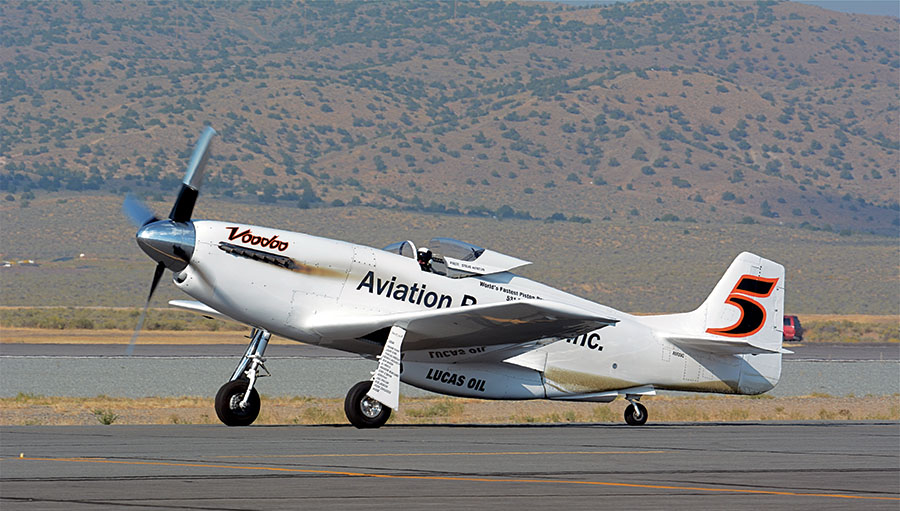
Voodoo’s left side displays a stream of oil on the aft fuselage after a hard run around Reno’s pylons. The engine breather exits via a small hole in the trailing edge of the left wing root fairing, and this river of oil blown onto the aft fuselage speaks volumes about how hard this engine has been working. It also shows the slipstream stays organized in this area. A similar but far less voluminous trail from the right root fairing is generated by the engine oil tank breather exit.
Bob further reports nothing special was done to the record engine other than a fresh overhaul. This makes sense as Merlins have been hot rodded for ages, and there can’t be much new to explore.
More accurately, the engine program has likely peaked and is now holding on by its valve cover nuts because the fundamental parts—the crankcases, cylinders, and cylinder head castings—have been fighting, flying, and racing for 73 years and they are tired, which came to bear during the record run.
Making Slippery
Aerodynamics, on the other hand, don’t wear out and continue to evolve. The low hanging P-51 fruit, such as smaller canopies and clipped wings, was picked decades ago, followed by some of the plums higher up the tree, such as straightening the vertical tail, changing the wings’ incidence, streamlining the belly scoop, and plenty of other unseen details.
As recently as 2016, Chiavetta was inside Voodoo‘s fuselage where ram air and the coolant radiator do their best to not cause too much drag via the Meredith Effect. (See “The Meredith Effect—Fact or Fiction?” March 2015 for more on Meredith Effect and its application to RVs.) Originally, Voodoo had an oil-to-air oil cooler in the belly scoop, like a stock Mustang, but this was replaced by an oil-to-water heat exchanger some time ago.
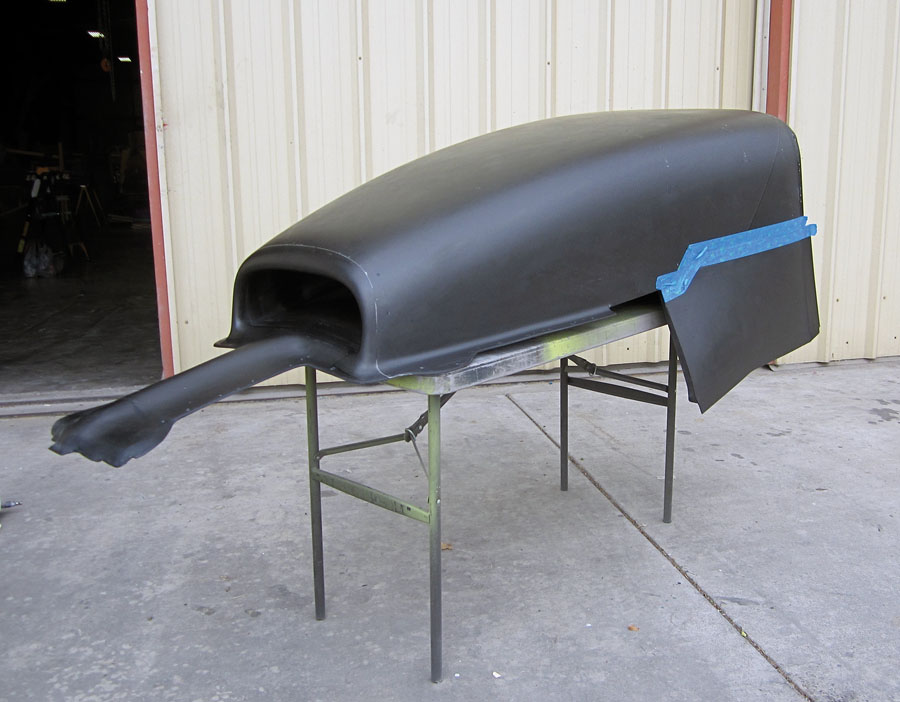
Seen during construction by Andy Chiavetta, Voodoo’s belly scoop is actually the outer streamline fairing that goes around the separate air ducting. Like so much of Voodoo’s reworked panels, the scoop is entirely carbon fiber.
Interestingly, what Chiavetta was up to inside Voodoo was recreating shapes pioneered on another P-51, Dago Red, years earlier. Those shapes had been carefully reengineered for better efficiency at the higher racing speeds, rather than the original WWII era contours. Furthermore, the reshaping in Dago Red had been done with a chopper gun and fiberglass, while Voodoo got much lighter carbon fiber lay-up additions. “We saved about 300 pounds with carbon fiber,” said Chiavetta, who went on to dryly note, “Of course, we added weight in other areas…” All told, Voodoo weighs 7,200 pounds empty and 9,000 pounds ready to race according to Hinton.
Reaching for 550 mph
For the final push to the mid-500-mph range, the team had few choices. Thrust was already maximized, the airframe extensively lightened, cutting down any more wing or control surfaces would be begging for stability trouble, and the surface smoothness of wing and fuselage was already slick as a baby-kissing politician. What could be done, thanks to modern tools, was recontour the existing wing to a different airfoil featuring a slightly higher critical Mach number that would remove some of the drag on the aft portion of the wing. As Button put it, “Joe and his partners and his engineering group…took the laminar flow wing and [re]designed it to keep the air off the flaps and ailerons.” Clearly this isn’t a casual change and why Joe Clark’s resources at Aviation Partners were so important.
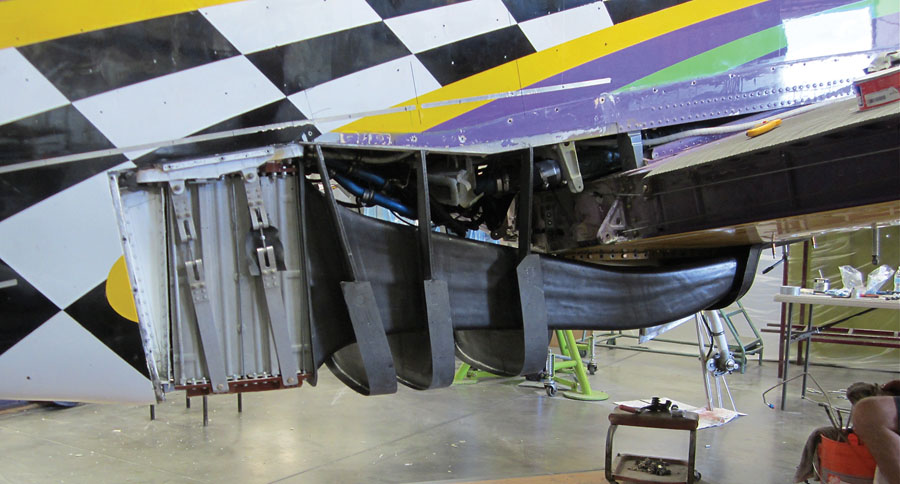
Without the outer belly scoop the actual air duct and its supporting bulkheads are visible. The radiator is the aluminum box supported by two straps, and obviously the paint is Voodoo’s earlier scheme from 2016. Chiavetta says much of the work with the radiator scoop was optimizing the shape for the higher airspeeds Voodoo races at.
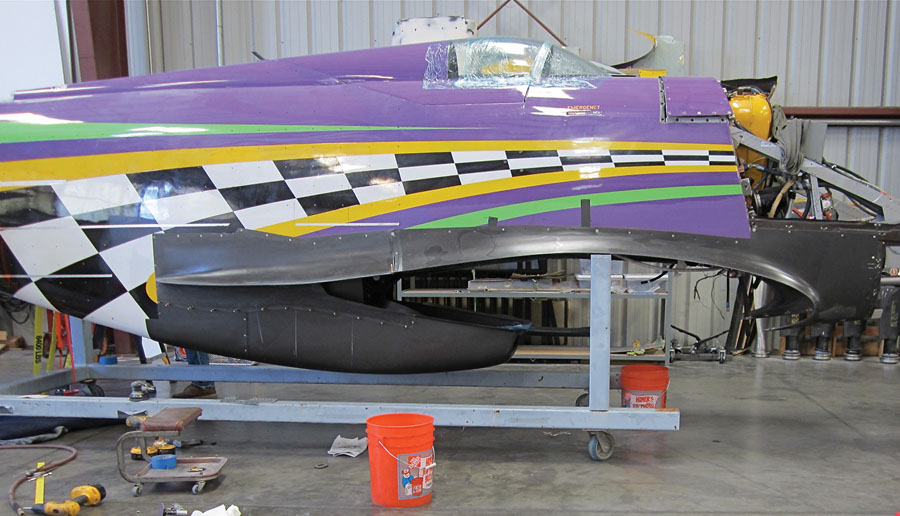
Another in-process shot, this time with the outer belly scoop fairing in place, shows just how serious racers get about disassembling their hot rods between races. Also plainly visible are the carbon fiber wing root fairing bits.
Changing the airfoil was done by stripping the wing of all paint and fillers, then digitizing the wing top and bottom to recreate it in a computer program. Using, among other things, Aviation Partners’ CFD program, the desired new airfoil shape was digitally formed over the existing wing surface so that between the existing P-51 wing and the new airfoil shape was a layer of varying thickness that needed filling in. The result was a shape that could overlay the aluminum wing skins to form the new airfoil surface.

As part of a general cleanup, the fabric rudder was recovered for the record attempt, while the vertical stabilizer was all new in 2016. As Button pointed out, “We tightened everything possible. Steveo spent months on the canopy… we tightened the gear doors, sealed everything, made it straight as possible. It was a year of really hard work.”
For computer modeling and fabrication practicality, this shape was apportioned into 34 pieces—Steveo says he doesn’t know what else to call them, so he labeled them “bumps”—that were built in the Aviation Partners production shop. The bumps were both riveted and bonded to the aluminum wing, then faired together to form a seamless surface.
Steveo says the bumps were built using “foam with vacuum-packed fiberglass of some sort. It flexes with the wing.” Carbon fiber was specifically ruled out because it is stiff and doesn’t bend like the underlying aluminum P-51 structure and would have caused point-loading issues.
“It took about a month to receive and attach the bumps and pretty much fair in the wing mods,” says Steveo, who went on to emphasize, “The hard-core aero work was done by Aviation Partners, while the Voodoo crew mainly supplied the labor on this part of the upgrade.”
Probably because it was far easier, and absolutely because Joe Clark likes white P-51s (his old buddy Lyford’s ’51 was all white), Voodoo abandoned its previous purple-and-checkerboard harlequin paint job in favor of the classic all-white do. Color sanding and a final clear coat was applied for maximum smoothness.

Perhaps the best place to view the heavily reflexed wing is from below. The new wing shape developed by Aviation Partners extends 24 inches forward of the flaps and is up to 2 inches thick in places. Due to fixed points around the ailerons and such, the majority of the wing reshaping is from the ailerons inboard.
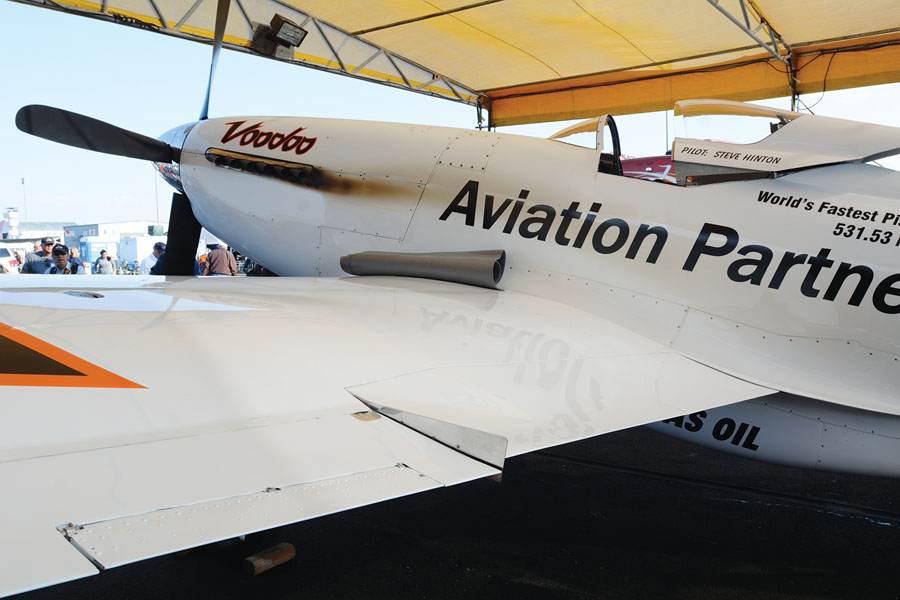
It’s more difficult to see the new airfoil shape from the top, but there’s a definite bulge about two-thirds along the chord, followed by a concave trailing section. Like the bottom, the wing’s upper surface is wonderfully fair. Button’s comment on his racer’s new finish was, “The airplane is 73 years old, and this is the finest set of clothes she’s ever worn.”
Button emphasized the care spent selecting and verifying the new airfoil. “Joe put it into his computers…he did it section by section. The whole process was about six weeks to two months behind because there was a safety concern for awhile; everything was based on safety factors. There was a concern that the changes might play a part in inducing flutter to the ailerons. By itself this is OK; it’s an acceptable risk. But at those speeds it might take other parts of the wing with it.
“So, through Aviation Partners, they gave us a computer version of an extremely efficient and safe wing. Then we took it through our testing [with the core Voodoo team members] because we wanted everyone to agree that it was safe. This is all for fun; I wasn’t emotionally prepared for that [killing someone]. Once the whole group was convinced we had a safe airplane, we headed to Idaho to Joe’s ranch.”
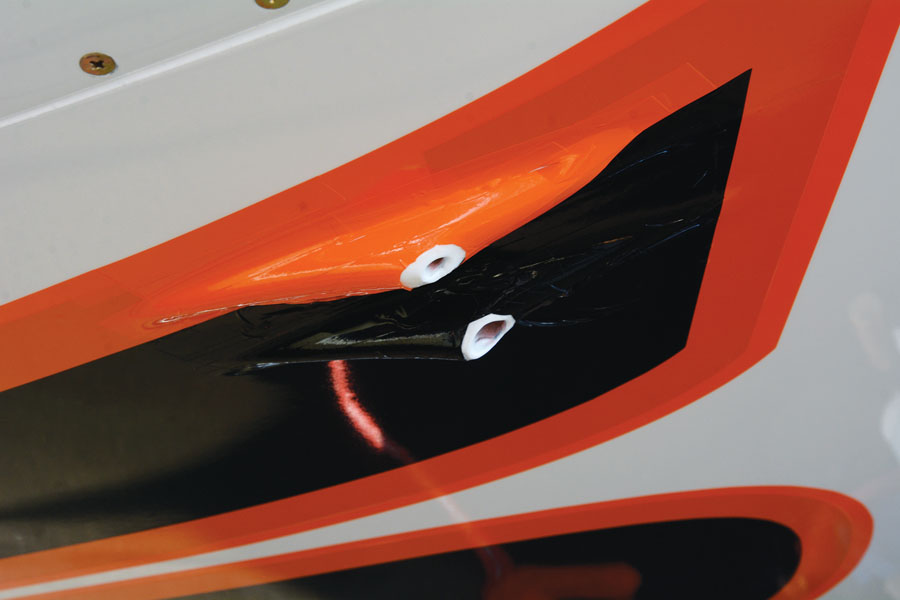
There are no tubes or wires hanging out in the breeze on Voodoo as this heavily faired under-wing fuel tank vent attests. Probably the least aerodynamic items are the vinyl letters and race numbers; at 500+ mph even those small but sharp edges must trip a lot of air.
Record Runs
Yolo County Airport in California is Voodoo’s home base, but for the record attempt the team wanted more privacy, higher elevation for reduced air drag, and hot air for a higher speed of sound to reduce transonic effects. Once again, Joe Clark had the answer at his Idaho ranch, complete with its private airstrip.
Upon arrival at Clark’s spread in August of 2017, the first issue was visibility. “Usually it’s picturesque, but this year there was smoke,” said Button, referencing the region-wide haze from all the fires in the Northwest. “Visibility was a problem, so Joe rented six light plants to put at each end of the course so Steve would not get lost. Also, when he was turning back to the north, there were solar panels which Steve could see.”
While losing sight of the record course sounds like a rookie error, it’s almost always a factor in record attempts because the pilot is busy, the courses are often arbitrarily set over open, barren terrain, the pressure is on because the engine is set to “grenade” power levels, and there are at least three 180-degree turns to be made.
Wanting a dress rehearsal, Button had the team run through a half test of once up and back on the 3-kilometer straight and level course. All went well and the post rehearsal check showed Voodoo in top form.
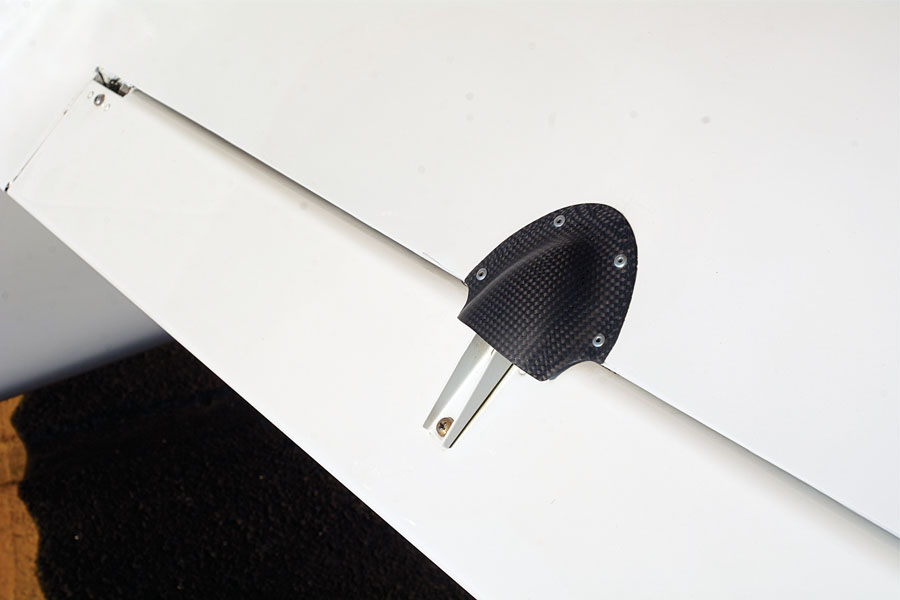
Voodoo’s elevator trim tab linkage got this nifty carbon fiber fairing. Unlike the Formula 1 and Biplane racers, the Unlimiteds, T-6s and Jets don’t bother taping every last little gap.
Next up was the actual record attempt. But the engine “sneezed”—Unlimited air racer shorthand for backfired through the inlet tract. Now, a backfire in a naturally-aspirated engine is a startling if not typically life-threatening event thanks to a noisy report through the throttle body, but in a large, supercharged engine like the Merlin, “sneezing” is a euphemism for a small bomb going off. That’s because the inlet is huge and crammed full of gasoline and air. Similar backfires blew the Macchi M.C. 72 out of the sky, killing its pilot before the war, and have been detonating inlet tracts and lower cowlings off racing Mustangs since racing resumed at Cleveland 70 years ago. Some variation of a hung-open intake valve is often to blame, but that’s not the only possible cause.
Thanks to a frangible carbon fiber inlet duct built by Chiavetta, Voodoo’s sneeze was easily survivable, and the airframe damage was quickly fixed. But the engine was torn down on the “B” side—Merlin speak for left side—with the cylinder head sent to Vintage V-12s for reseating the intake valve seats in the cylinder head castings. These had worked loose, no doubt causing the backfire, and are indicative of the tired nature of Merlin parts today, as they’ve been around forever, and no one knows how many zillion heat cycles the castings have been through. At some point the aluminum cylinder head casting has relaxed such that it can no longer hold its shape and things come loose.

Sighting forward along the right wing root fairing gives another view of the swoop in the wing’s trailing edge, along with a peek at the tiny vent hole for the oil tank breather.
With the B head tidied up and the engine reassembled, the record attempt was run again, this time to completion. Those runs are viewable on YouTube and look like a jet making piston-engine noises. But perceptive viewers will notice the four passes are not equally fast, and it’s no illusion. Voodoo clocked 554.69 mph on its first 3-kilometer pass, then 527.34, then 528.48, and finally an obviously wounded 516.62 mph on the fourth pass. Post-run testing showed low cylinder pressure on the B bank, or, as Button put it, “This is why we lost power on the record runs—the head was coming apart again.” A healthy Merlin capable of four consistent passes would have easily given Voodoo the official title of world’s fastest piston-engine aircraft. Next time, if there is a next time.
In the meantime the Voodoo equipe must settle for knowing they’ve run faster than any piston engine airplane in history.
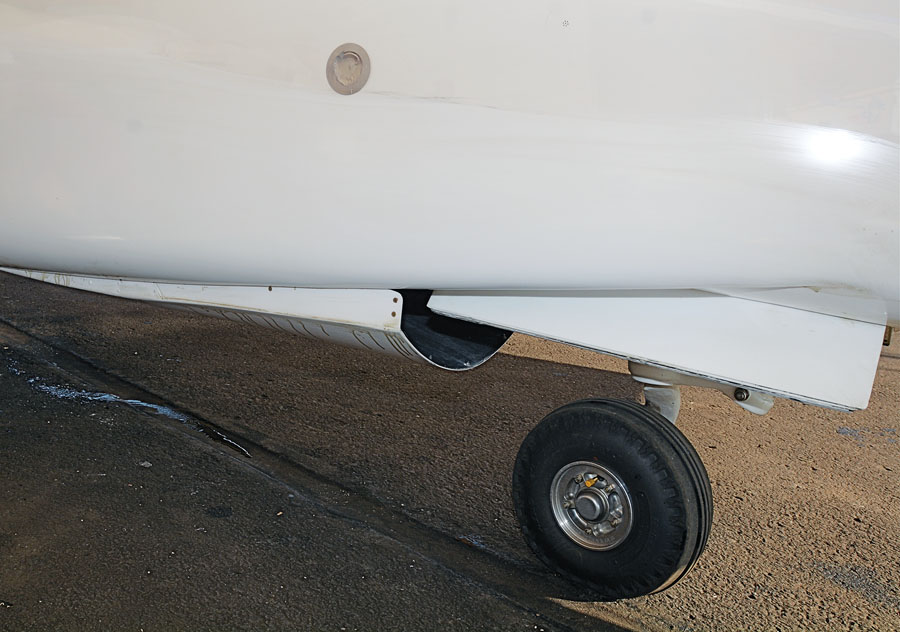
As Bob Button explained regarding the radiator exit door, “The exit scoop was extended in the 1990s, and we’ve modified it over the years. The thing is to move the low pressure aft. If we didn’t have a tailwheel, we could go farther back.”
Reno 2017
With the pylon races looming, more record attempts were set aside, and Voodoo made ready to battle Strega at Reno. The record engine was removed and once again resurrected by Vintage V-12s, while the team’s other Merlin went into the airframe for Reno. In the Unlimited Gold race Voodoo jumped Strega at the start and held a slim lead until just before the end when lapped traffic allowed Strega to slip inside for the win. No one else was in the same zip code.
All during Reno week, Button said the event was Voodoo’s last hurrah. After 23 years, and in the face of a dwindling purse for even the headlining Unlimited racers, it was time to move on. What will become of Voodoo remains an open question. Too modified to return to stock and be sold for five times its worth as a racer, too expensive to race, and beyond practical application as a sport plane, Voodoo seems destined to fade mutely as a museum piece.
Unless, that is, the outright piston speed record keeps calling the faithful to the sacrifice.
Our Lessons
So, what’s to learn from Voodoo? It reminds us that specialization has its price and to carefully plan what we wish for. It reminds spectacularly that speed costs money; how fast do you want to go? It shows attention to detail in every aspect is paramount to superior performance. It reminds that no matter how loose the confederation, no one does this alone. It shows that as you go faster, aerodynamics is the greatest of the equals of power, reduced drag, affordability, minimum weight or size, or any of a hundred other considerations. And above all, for all its impracticality, it shows tangibles are just what we can prove to others, and when the spirit moves us, great things can happen.

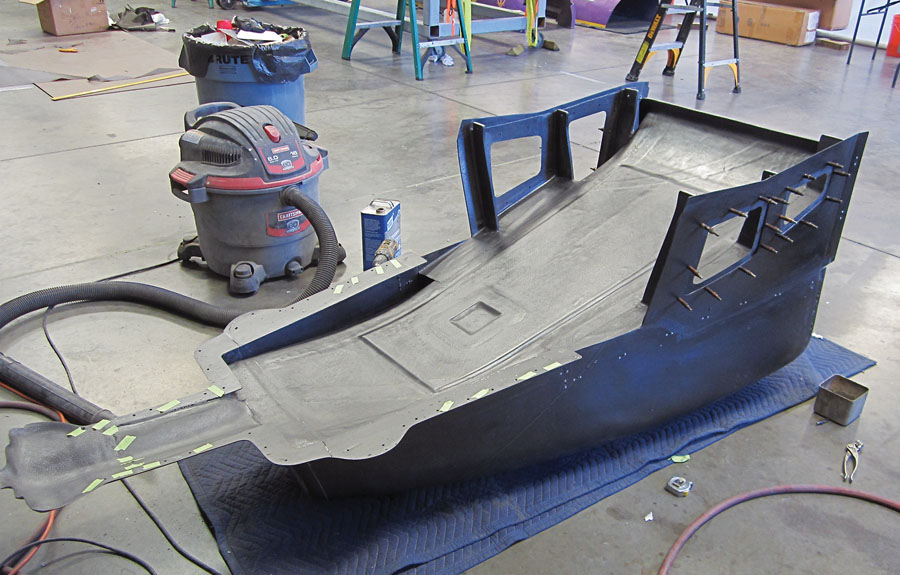
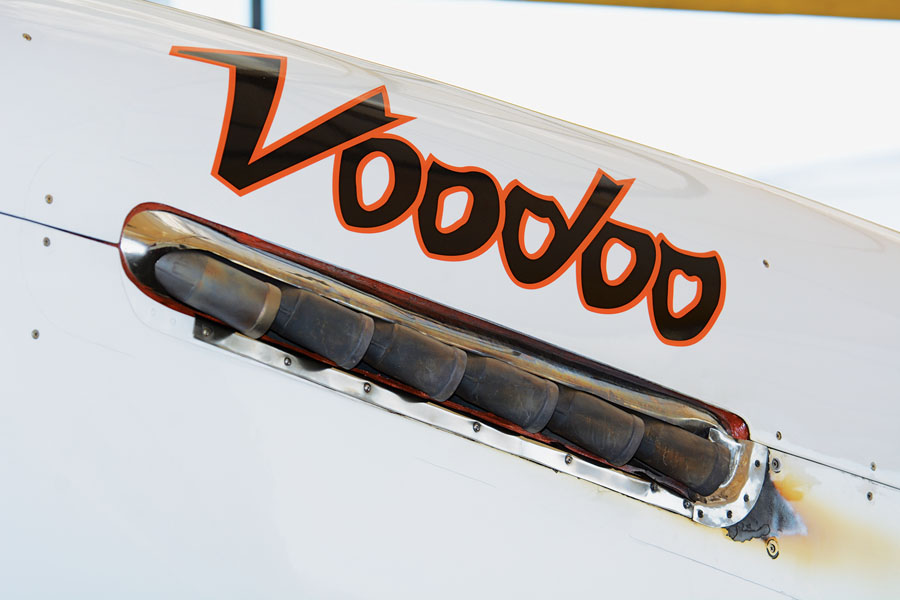
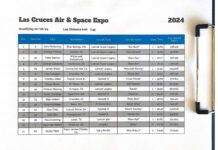

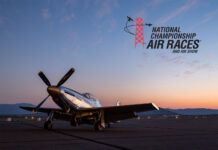
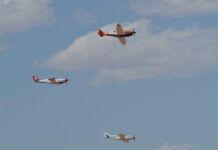
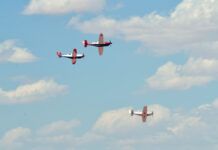

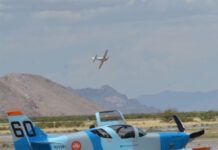
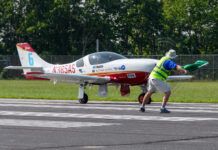

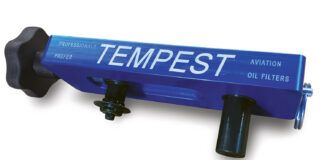
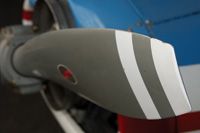
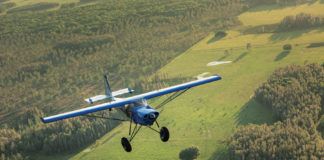
What is the engine torque produced by Voodoo?
This is tough to say, as the engine has never been dynoed (no one has a dyno capable of this sort of power) so we’re working with guesstimates. That said, the Merlin in Voodoo is estimated to make 3,500 hp at maybe 3500 rpm. Doing the math with those figures gives a torque of 5,252 lb ft.
Just to play with the numbers, if the same horsepower–3,500 hp–was made at 3400 rpm then the torque would be 5,406 lb ft.
In any case, it’s enough to wring a wet pair of Levi’s.
Not so incidentally we ran into Stevo at Reno and he said the team has identified their engine issue and another speed record attempt was a possibility. It all depends on will and money, so we’ll see.